Challenges and Best Practices for Frozen Food and Cold Storage Warehousing

Cold storage warehouse management is a highly specialized skill. It requires intimate industry knowledge and the ability to make the best use of materials, equipment and facilities. Good cold storage warehouse managers are intimately aware of their frozen product requirements. They continually respond to critical issues that arise when handling perishable foods.
Professional cold storage managers know about everything that occurs inside and outside their warehouses. They’re responsible for overseeing details like cold storage freeze times and cold storage freezer equipment safety. They know specific challenges that face them and how to best navigate around those challenges. Facility managers are also responsible for the safety of their employees, including making sure they’re properly trained, motivated and compensated.
Frozen food warehouse management takes years of dedicated learning and keeping up with emerging business trends. It also involves being current on technology. For example, automation in the cold storage industry has changed drastically in the last decade and will continue evolving well into the future. Even though many warehouse duties are performed manually, technologies like autonomous mobile pickers, the Internet of Things and autonomous inventory robots are expected to automate many responsibilities over the coming years.
Good managers plan ahead to avoid frozen food warehouse management problems. They alsonetwork with others in the industry who help them with fresh ideas on where to source the newest cold storage industrial equipment, like the best plastic pallets, pallet inverters, freezer spacer removal models, dispensers, stretch wrappers and more.
Cold storage of frozen foods is a massive industry across America and around the world. Demand for food increases proportionately to the population — both of which are on a steady rise. Harvard Business Review reports that the world’s population may reach 9.7 billion by 2050, growing by over 2 billion based on the most recent population estimates. Due to this population increase, food demand will rise somewhere between 59% and 98% by 2050.
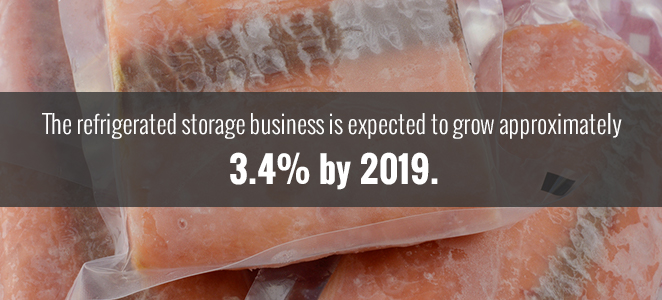
As this demand rises, experts forecast that the global industrial refrigeration system market will increase by 4.3% between 2019 and 2025. This increase will turn a $19.3 billion industry into a $24.8 billion one in only a few years. The best cold storage facility managers are acutely aware of these predictions and take proactive steps to prepare for business expansion opportunities.
The frozen food warehousing specialty has specific requirements for temperature-controlled environments, and managers of facilities who handle these niche markets have their own industry challenges. In this cold storage and frozen food warehouse management guide, we’ll cover some of the most prominent challenges managers face, and discuss best practices you can implement to navigate around them successfully.
Frozen Food and Cold Storage Warehouse Management Challenges
Cold storage warehouse managers have an enormous burden in taking care of daily business, while simultaneously staying on the hunt for ways to improve how they handle challenges ranging from strict regulations for food handling to rules for storage and temperature. Other challenges include maintaining the perfect temperature for proper food storage while keeping staff and equipment warm enough to perform at peak efficiency. Your reputation, profits and ultimate success depend on recognition and successful management of these and many other common challenges.
The largest segment of frozen foods is in the meat, cheese, poultry, seafood and dairy worlds that make up the mainstay of perishable food items. Facility managers who handle these time- and temperature-sensitive products must be on top of their game to prevent small material handling mistakes that could turn into catastrophic financial losses. In the cold storage world, little things really matter.
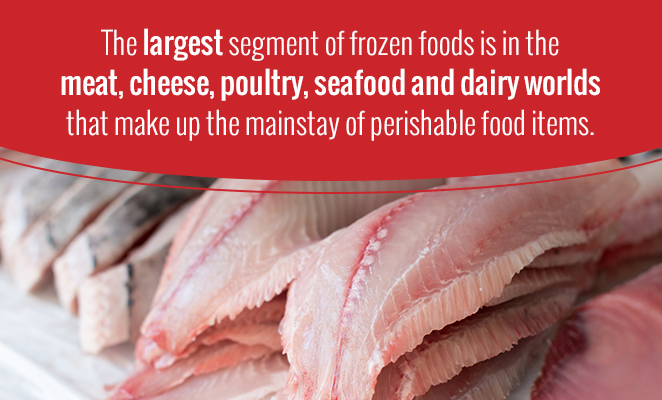
Let’s look at some of the most common challenges the industry faces so we can find warehousing solutions and best practices to combat frozen food and cold storage warehouse management issues.
1. Time Management and Compliance
Efficiency and product control are high priorities for cold storage facility managers. They must use time-tested processes as well as implement new industrial equipment that makes their business run more smoothly and, ultimately, more profitably. These professional managers must constantly look for systems and solutions that reduce waste, eliminate unnecessary cost and improve worker safety. The fundamental goal is to prevent losing food products and profit.
Different products require different temperatures for cold storage freezer food safety and product freshness. You’ll face strict regulations from OSHA and industry guidance from the FDA regarding your practices and products if you’re a cold storage warehouse manager, which means staying ahead to remain compliant.
2. Protecting Food Products
If you’re in the frozen food industry, you know different products require unique temperatures to keep from spoiling. You’ll need to regulate and maintain both humidity and temperature in your warehouse to extend the life of your products as much as possible. It can be challenging and risky, and traditional temperature monitoring systems are 100 percent dependent on operator experience. Someone must be onsite to manage the whole system is managed and make proper adjustments if temperature or humidity fluctuate.

3. Upkeep of the Food’s Life Cycle
It’s no secret keeping frozen food from spoiling due to undergoing the wrong conditions is one of the biggest challenges in the market. Several issues can occur without the proper maintenance of a product’s lifecycle. You have to keep on top of the temperature of perishable products at all times if you’re in cold storage warehouse management.
The upkeep process is about the quality and safety of the foods in your warehouse, which means you must keep a close watch and tight management over their conditions from the point of manufacture all the way through the supply chain to the point when they reach consumer hands. Without this level of oversight, shipments of food products could undergo discoloration, textual degradation, microbial growth or bruising.

4. Requirements for Accurate Product Tracing
At all times, you need to have accurate location information about the products that move through your warehouse, so you can determine affected products in situations with sudden or unexpected temperature changes. Without exact traceability, it would be impossible to locate these products. Fresh produce and similar perishable products require even more management and control over external factors like humidity and carbon dioxide.
It’s not easy, but to overcome this challenge and achieve proper traceability for all your products and their various requirements, always practice accurate and precise documentation.
5. Labeling of Racks and Individual Products
You probably already know how crucial barcode labels are. They create the link between each physical product in your inventory and your computer systems that monitor receiving, storage, retrieval and shipments. A single forgotten or lost label could lead to an unsafe or entirely ruined shipment.
Freeze-grade labels appropriate for each product and situation are a critical factor in successful cold storage warehouse management, as they can develop a strong, permanent bond on common rack services. Your personnel can apply them in environments as low as negative 20 degrees Fahrenheit, and you can rely on them to stay on no matter what your daily operations entail.
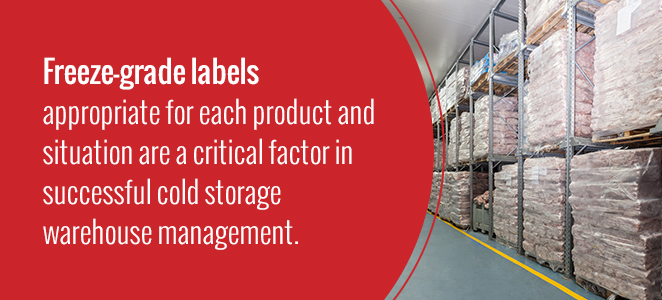
6. Courier Shipments and Fulfillment
Arguably, the most crucial part of cold chain process management is minimizing the amount of time it takes to push a product from the beginning to the end of the system. Staying efficient the entire time is critical. Without a precise level of effectiveness, the vulnerabilities we discussed earlier could begin negatively affecting the products. Delays in moving products from one facility to the next can give these issues more of a chance to manifest and force you to lose time and profits.
Each average shipment, inbound from the supplier to the distribution center as well as outbound to customers, should consist of amounts of food products that are less than truckloads, which can be difficult to maintain. Next, you need to load the products correctly each time so you don’t risk cross-contamination with raw products or crushed or damaged food that ended up under heavier items. During shipments, perishable foods like seafood, ready-to-eat products and precut produce can turn unsafe if they are kept at the wrong temperatures.
Frozen Food and Cold Storage Warehouse Management Best Practices
Organizing and executing activities within a cold storage environment is all about information management and systems application. It’s tough to keep up with tasks, let alone stay ahead on new ways of doing business, but those with the right practices know exactly how to manage their frozen food warehouse with little to no trouble.

Fortunately, experienced facility managers are willing and eager to share tips on effective cold storage management, and so are professional material handling suppliers like Cherry’s Industrial Equipment. Cherry’s Industrial has been in the business of supplying industrial equipment to the cold storage and frozen food sector since 1983.
These best practice tips form a cold storage and frozen food warehouse management guide from Cherry’s Industrial Equipment — and a host of industry experts — that is sure to give you solid information on managing a cold storage warehouse facility and keep you following the best practices for years to come.
1. Create a Contingency Plan
Any number of cold storage warehouse management problems could arise, and you can’t always predict what’s going to come next. That doesn’t mean you have to wait for disaster to strike. On the contrary, you should be constantly creating contingency plans for any possible problem that could pop up at any point in the process. A truck could break down during transport, or one of your refrigeration units could stop working suddenly. You need to be sure your carrier or 3PL is entirely prepared to respond appropriately and avoid loss.

You might have the best monitoring technology and systems on the market, but unplanned rerouting or delay could still jeopardize your shipment. It’s crucial for shippers to work out contingency plans with their transportation partners to fully and clearly map out strategies in anticipation of an unexpected issue or delay. Everyone throughout the process should know the proper steps of the contingency plan so all your bases are covered.
2. Avoid Delays by Training and Fostering Relationships
Minimizing the time a product takes to move through the system is a key way to avoid damage to your goods, but how can you avoid delays? One of the most crucial factors in creating an efficient process is ensuring everyone down the line understands frozen food warehouse management best practices.
Cold chain handling, transportation and delivery come with several crucial responsibilities, which means you must thoroughly train employees and make them aware of your expectations. Strong partnerships must exist among all parties for the consumer to receive the most wholesome product with the longest possible shelf life and highest nutrition and value.
3. Manage Temperature Ranges to Optimize Space
The fact that it costs more to cool air than heat it makes energy savings an important topic of discussion in frozen food warehouse management. However, you can’t just choose one temperature and put every product in your warehouse within that range.
In cold storage warehouse management, you must take temperature into account. In most cases, food will require several temperature zones. Different food items like vegetables, dairy products, ice cream and meat require different temperatures, with many varying quite a bit — from about 55 degrees Fahrenheit to negative 10 degrees Fahrenheit.
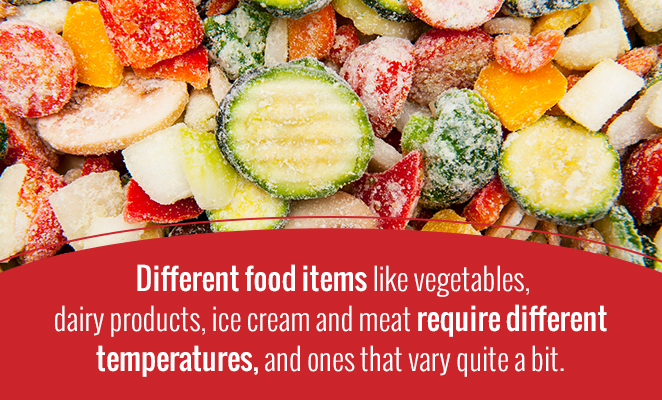
An example of time-tested systems in the cold storage industry is establishing temperature zones within a warehouse facility to optimize your space. In a conventional warehouse, reconfiguring space isn’t usually much of a problem. Managers can move items as they choose to make more products fit within the confines of an area.
If you choose low-risk, flexible options like modular curtain walls that can easily go up, come down and change buildings with business needs, you’ll be able to thoroughly manage temperature ranges in cold rooms and gain more cost savings.
4. Temperature Forecasting
As the products you store will likely change with the seasons, you can’t get complacent and assume that your temperature zones now are going to be the temperature zones you need later. For example, ice cream is in higher demand during warm months. While it’s warm out, refrigerated warehouses will need to dedicate more space to their freezing zones to accommodate the influx of ice cream. The best warehouses use temperature forecasting to expect needs and adjust their warehouse space accordingly.
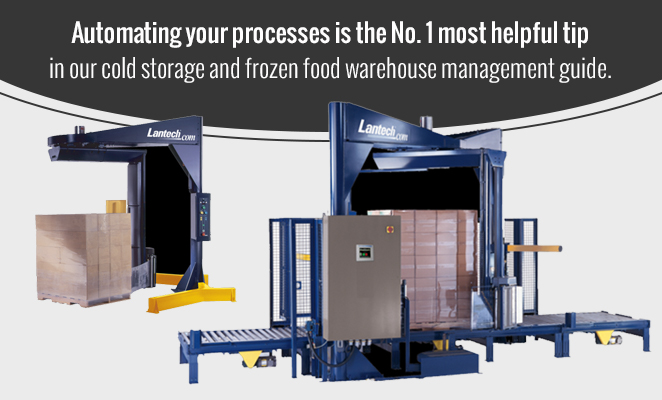
In addition to seasonal changes, you’ll also be watching out for new clients who may need you to make adjustments to your facilities to store their products properly. With temperature forecasting, you’ll be aware of changes in the industry and companies that may be looking for a new storage provider.
Temperature forecasting also helps warehouse facilities anticipate the demands of the market, either tried and true products that change seasonally or a new product prepared to hit store shelves. Along with predicting what will be in greater demand, forecasting helps your company know what changes you’ll need to make. You may need to put up modular curtains, for instance. Knowing that information far ahead of time allows you to stay ahead of challenges and be prepared.
Predicting changes and acting on them with high-quality data at your side is crucial to the financial success of your company. The result of temperature forecasting means you can adjust your storage space to an optimal layout that generates higher profit per square foot. Additionally, you’ll have more satisfied customers who you’ll never have to say “no” to when it comes to any of their new storage needs.
Proper temperature forecasting will incorporate a variety of factors, such as historical data and contemporary information. Current information typically includes estimates about your industry, space requirements per unit, preorders and much more.
5. Automate Your Processes
Automating your processes is the No. 1 most helpful tip in our cold storage and frozen food warehouse management guide. Most people realize how much the cost of labor, land and energy increases from year to year. This economic climb makes it a best practice for operators to look into automation to control their costs. This process allows for automated palletizing, maximum dense storage in each cube and controlled heat loss. Not only will you realize cost savings quickly, but you’ll also continue to save money over the long term.
Automating material handling steps like freezer spacer removal and freezer spacer insertion are technological improvements every cold storage warehouse manager can capitalize on to reduce worker time and improve the business’ bottom line. Automating the supply chain is a leading tip every experienced cold storage manager will pass on.
On the market today are new robotic technologies, energy supplies, doors and barriers, seals, cables and lubricants designed to function well in harsh freezer environments, allowing palletizing to happen inside your freezers. Instead of protective heating shrouds, conveyors and ice buildup on each product, new technology can help you minimize the handling of all frozen goods by workers, increase your speed and enhance your overall productivity and efficiency.
Frozen Food and Cold Storage Warehousing Equipment
Let Cherry’s Industrial Equipment be your 3PL of complex cold storage solutions like freezer spacer retrievers and inserters or simple devices like freezer separators themselves. Cherry’s Industrial has the right equipment for your cold storage freezer management, large or small. We’ll help you bring your warehouse to the next level when it comes to efficiency and compliance.
The following custom products are just a few of the most helpful solutions we have provided our customers for ergonomic assistance, productivity increases and safety and sanitation improvement.
-
- Freezer spacers and retrievers: Cold storage facilities and meat processing plants equal increased demands and heavy workloads. Our several models of spacers and pallet retrievers will give you a chance to combine loads and switch pallets quickly and easily. This USA-made equipment provides reliable components, simple controls and user-friendly operation for a more streamlined production process.
- Plastic pallets: Since wooden pallets are no longer the industry standard like they used to be, plastic pallets are much more useful in warehouses. They eliminate product contamination, require no heat treatment and reduce cleaning time. They last longer and tolerate repeatable tare weights while offering consistency in their dimensions. We offer a variety of heavy-duty plastic pallets that you can stack and reuse repeatedly. Some examples include FDA-approved HDPE, aluminum, smooth top, drum, and so on.
- Pallet inverters: If it sits on a pallet and needs to be turned, our equipment can handle it. Our huge inventory of pallet inverters (for purchase, lease or rent) eliminate the need to transfer loads manually onto another pallet. You can reduce workplace injuries, lower costs and eliminate a large amount of product damage by choosing our heavy-duty inverters that rotate 180 degrees and work for many applications.
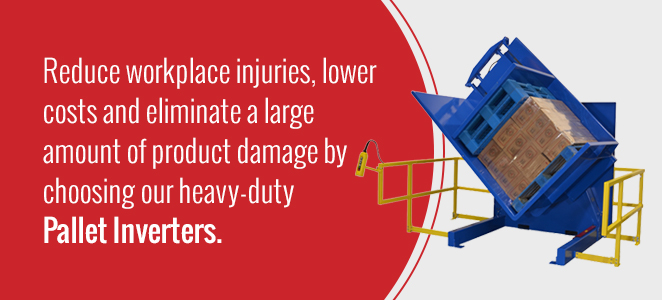
- Stretch-wrapping equipment: Our overhead, turntable and robotic stretch wrappers come from some of the most trusted brands on the market. Our countless styles and designs help by automatically wrapping pallets or products. The stretch film with 200 percent pre-stretch will stabilize loads and reduce product damage at your warehouse. By adding automated stretch wrappers to your facility, you could earn an ROI that includes saving thousands of dollars and hours.
Follow Best Practices With the Best Equipment
By knowing the most crucial challenges and best practices of frozen and cold storage warehouse management you will appreciate the importance of having good equipment for a successful operation. The people making and providing your equipment should have years’ worth of material handling experience, and they should be using cutting-edge technology to deliver a wide range of equipment to suit any unique application on your to-do list. With Cherry’s Industrial Equipment, that’s exactly what you’ll get.
When you choose to partner with us, you’ll quickly realize the return on investment our equipment offers. In addition, you will also witness a cleaner and more professional facility which will improve the overall reputation and credibility of your company both with your workers and the public alike. You’ll be able to meet and exceed strict OSHA compliance standards and reduce the number of workers’ compensation claims in your facility, even if that number is already low.

To see your bottom line improve and keep both staff and customers safer, learn more about us and get answers to all your questions by calling us at 800-350-0011. You can also request a quote on our equipment today — we look forward to serving you.